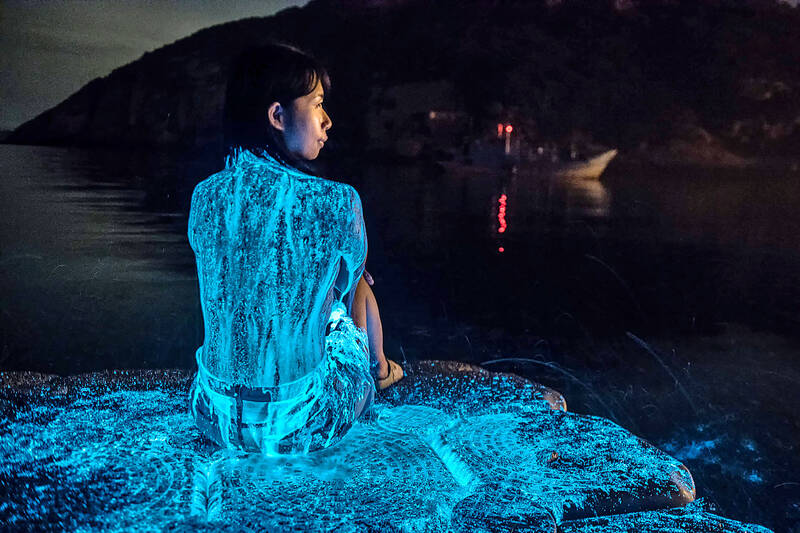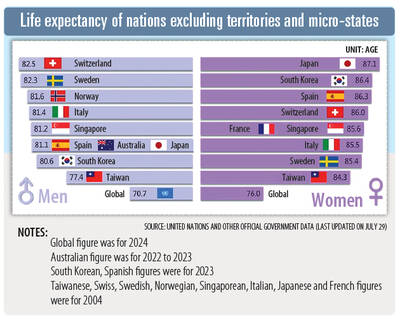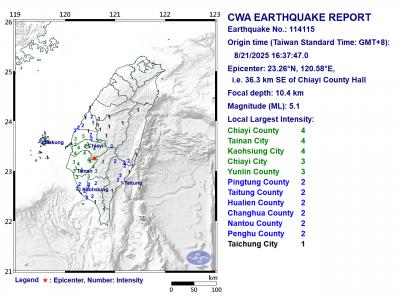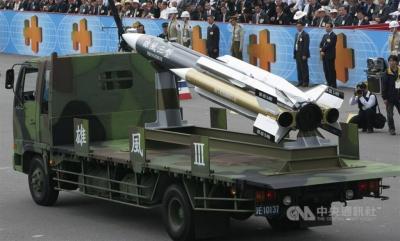A viral photograph of a tourist covered in bioluminescent algae and glowing a fluorescent blue on the Matsu islands has sparked debate over whether such actions harm the environment.
The photo was originally posted online on May 17 by Chou Chih-hsiao (周治孝), a resident of Lienchiang County’s Beigan Township (北竿) who runs a Facebook group devoted to the luminescent phenomenon, which is known locally as “blue tears.”
Chou said he had achieved the effect in the photo by splashing large amounts of algae-laden seawater onto the subject, and then quickly taking a picture before it washed back into the sea.

Photo courtesy of Chou Chih-hsiao via CNA
Lin Wen-fu (林文福), a bed-and-breakfast owner on the county’s Dongju Island (東莒島), said there had been a massive algal bloom from May 14 to Wednesday last week.
Chiang Kuo-ping (蔣國平), a professor at National Taiwan Ocean University’s Institute of Marine Environment and Ecology, on Tuesday played down both concerns.
The phenomenon occurs annually between March and early July, when the Min River in China dumps large amounts of silicates into the waters around the Matsu islands, he said.
This influx of silicates creates an explosion in the population of microalgae called diatoms, and in turn, the Noctiluca scintillans algae that feed on them, Chiang said, adding that the bioluminescence is caused when the algae is disturbed.
The silicates that prompt N. scintillans blooms often come from land-based sand rather than pollutants, and the “blue tear” phenomenon is relatively “normal” in areas with turbid, nutrient-dense waters, Chiang said.
He said the vast majority of the algae captured in photos such as Chou’s flow right back into the sea, so the impact “is not very large.”

STATS: Taiwan’s average life expectancy of 80.77 years was lower than that of Japan, Singapore and South Korea, but higher than in China, Malaysia and Indonesia Taiwan’s average life expectancy last year increased to 80.77 years, but was still not back to its pre-COVID-19 pandemic peak of 81.32 years in 2020, the Ministry of the Interior said yesterday. The average life expectancy last year increased the 0.54 years from 2023, the ministry said in a statement. For men and women, the average life expectancy last year was 77.42 years and 84.30 years respectively, up 0.48 years and 0.56 years from the previous year. Taiwan’s average life expectancy peaked at 81.32 years in 2020, as the nation was relatively unaffected by the pandemic that year. The metric

Taiwan High Speed Rail Corp. (THSRC) plans to ease strained capacity during peak hours by introducing new fare rules restricting passengers traveling without reserved seats in 2026, company Chairman Shih Che (史哲) said Wednesday. THSRC needs to tackle its capacity issue because there have been several occasions where passengers holding tickets with reserved seats did not make it onto their train in stations packed with individuals traveling without a reserved seat, Shih told reporters in a joint interview in Taipei. Non-reserved seats allow travelers maximum flexibility, but it has led to issues relating to quality of service and safety concerns, especially during

A magnitude 5.1 earthquake struck Chiayi County at 4:37pm today, the Central Weather Administration (CWA) said. The hypocenter was 36.3km southeast of Chiayi County Hall at a depth of 10.4km, CWA data showed. There were no immediate reports of damage resulting from the quake. The intensity of the quake, which gauges the actual effect of a seismic event, measured 4 in Chiayi County, Tainan and Kaohsiung on Taiwan's seven-tier intensity scale, the data showed. The quake had an intensity of 3 in Chiayi City and Yunlin County, while it was measured as 2 in Pingtung, Taitung, Hualien, Changhua, Nantou and Penghu counties, the data

The Supreme Court today rejected an appeal filed by former Air Force officer Shih Chun-cheng (史濬程), convicted of Chinese Communist Party (CCP) espionage, finalizing his sentence at two years and two months for contravening the National Security Act (國家安全法). His other ruling, a ten-month sentence for an additional contravention, was meanwhile overturned and sent to the Taichung branch of the High Court for retrial, the Supreme Court said today. Prosecutors have been notified as Shih is considered a flight risk. Shih was recruited by Chinese Communist Party (CCP) intelligence officials after his retirement in 2008 and appointed as a supervisor